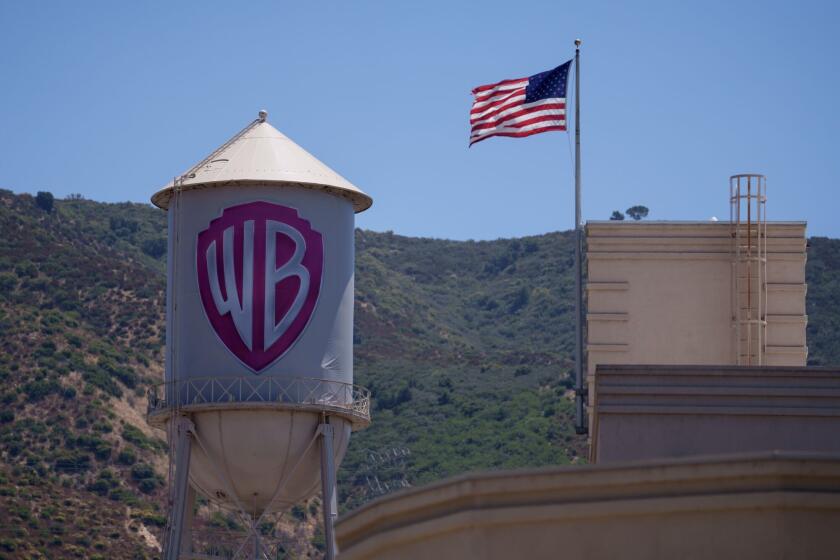Review: Philip Glass transforms opera, film with ‘La Belle et la Bête’
- Share via
SANTA BARBARA — Labeled an opera for ensemble and film, “La Belle et la Bête” is listed on Philip Glass’ website as one of his 26 opera scores and also as one of his nearly 50 film scores.
In fact, this opera/film, which the Philip Glass ensemble brought to Santa Barbara’s Granada Theatre on Wednesday night and will repeat Friday at UCLA’s Royce Hall, is one of a kind.
It is neither filmed opera nor live opera with film but, audaciously, both at the unrealistic same time.
A live opera/film, it a tribute to Jean Cocteau’s marvelous 1946 film of “Beauty and the Beast,” and a defacement — if loving rather than impudent — of it. Glass removed the soundtrack and replaced it with his own opera score meant to be performed live to the film, with the singers synchronizing their voices with the characters on screen.
Besides the sheer technical nerve of such an act, Glass also erases Georges Auric’s elaborate original score for orchestra and chorus. Cocteau’s filmic fantasy includes several lengthy musical sequences to create the supernatural atmosphere. “Belle” inevitably becomes something very different, of course. But what?
That was a question 20 years ago when Glass premiered his “Belle” as the second part of a Cocteau trilogy that began with “Orphèe” (a staged opera that uses Cocteau’s screenplay as a libretto) and “Les Enfants Terribles” (an opera for dancers and singers).
Glass’ “Belle” may be a gimmick opera, but gimmicks don’t last and operas do.
The timing for this revival of “Belle,” as part of a Glass weekend at UCLA and Boston Court serving as a grand finale to the citywide Minimalist Jukebox, is illuminating. One of the unusual opera skills Glass developed by working with director Robert Wilson was learning how to write music to fit movement.
In his first opera, “Einstein on the Beach,” which Los Angeles Opera presented in the fall, Glass and Wilson invented a new kind of music theater in 1976 in which music and movement were co-equals, related but not — as in dance, opera or cinema — part of a situation where one dominates the other.
Eight years later, for the Rome section of Wilson’s “the CIVIL warS,” which the L.A. Phil performed two weeks ago as part of the Minimalist Jukebox, the director created a full staging to which Glass then timed an operatic score, with arias and all.
“Belle,” another decade later, was the next step.
The Glass ensemble is onstage with the singers, the movie screen above them.
The vocal lines are, necessarily, parlando, which is somewhere between speech and song, and while considerable accuracy is required for lip-syncing, Glass calculated the rhythms down to the micro-second.
It is difficult, but there is much modern music far more rhythmically complex. The challenge is to make the vocal lines flow like natural speech.
Glass creates an entirely new atmosphere that enhances the film but also fights it.
In the opera, a saintly dreamy beauty and an elegant beast come to seem more archetypes than characters, particularly because the music is of our time and the old black-and-white French film is not, even restored and shown on an excellent new digital system at the Granada.
Two eras are juxtaposed, with the music updated and the movie not, which was radical 20 years ago but now is not, what with new scores regularly created for silent movies and everyone and his brother making new soundtracks for found videos on YouTube. But what has remained radical is the rethinking of the nature of music and film through the lens of opera. Although Auric had larger forces and was a master of instrumental color, he served the image on the screen. Glass changes the equation, transforming Cocteau’s work just as Belle transforms the beast.
The true test of Glass’ “Belle” would be to produce it as stand-alone opera. There is no question of that working because the opera is a complete success on recording.
Wednesday’s performance was further proof.
The touring version of the opera has significantly reduced forces. Originally Glass added a chamber orchestra to his six-member ensemble of keyboards and winds, and six singers handled the nine characters. Now there is just Glass’ ensemble and four singers, with Michael Riesman conducting.
The syncing wasn’t always accurate, especially with mezzo-soprano Hai-Ting Chinn’s buoyant Belle. Soprano Marie Mascari and baritones Gregory Purnhagen and Peter Stewart bounced between various characters with impressive facility. It was clear that they and the characters on the screen were not the same. But that phenomenon revealed all the more clearly the essence of this opera. The actors in the film are but shadows of something newer and bolder.
Near the end of the film, Avenant, Belle’s beau, breaks the window of the beast’s castle, and says, “It’s only glass.”
Only Glass, indeed. By shattering “La Belle et la Bête,” the film, Glass newly enters into the essence of opera.
More to Read
The biggest entertainment stories
Get our big stories about Hollywood, film, television, music, arts, culture and more right in your inbox as soon as they publish.
You may occasionally receive promotional content from the Los Angeles Times.











